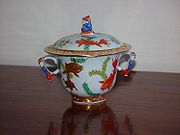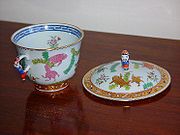
Herend Porcelain
Encyclopedia


Hungarian language
Hungarian is a Uralic language, part of the Ugric group. With some 14 million speakers, it is one of the most widely spoken non-Indo-European languages in Europe....
: Herendi Porcelánmanufaktúra Zrt.) is a Hungarian manufacturing company, specializing in luxury hand painted and gilded porcelain
Porcelain
Porcelain is a ceramic material made by heating raw materials, generally including clay in the form of kaolin, in a kiln to temperatures between and...
. Founded in 1826, it is based in the town of Herend
Herend
Herend is a small town in Hungary , near the city of Veszprém.The history of the town goes back into Roman times, indicated by the findings near the precincts of the town, while in the Middle Ages a few villages occupied the area where the current town stands...
near the city of Veszprém
Veszprém
Veszprém is one of the oldest urban areas in Hungary, and a city with county rights. It lies approximately north of the Lake Balaton. It is the administrative center of the county of the same name.-Location:...
.
In the mid-19th century it was purveyor to the Habsburg Dynasty and aristocratic customers throughout Europe. Many of its classic patterns are still in production.
After the fall of Communism in Hungary the factory was privatised and is now 75% owned by its management and workers. As of 2006, the factory is profitable and exports to over 60 countries of the world. Its main markets are the USA, Japan, Italy and Russia.
History
The factory at Herend was founded in 1826 by Vince Stingl as an earthenware pottery manufacturing factory, but also he had been carrying out research experiments on porcelain making. Stingl ran out of funds and subsequently went bankrupt, his creditor Mór Fischer took control of the factory in 1839. The new owner of the manufactory, Mór Fischer, being very ambitious and having new ideas, started artistic porcelain manufacturing in the same year. At that time it was almost impossible to replace broken pieces and supply old, classical porcelain dinner-sets from the Far East and from Europe, but Mór Fischer's efforts met the support of the Hungarian aristocracy already in 1840.The artistic demand, the effort of manufacturing the first true pieces in Herend succeeded in a very short time. The First Hungarian Applied Art Exhibition, the Vienna Exhibition in 1845, the Great Exhibition in London, 1851, the Exhibition of the Industry of All Nations
Exhibition of the Industry of All Nations
Exhibition of the Industry of All Nations was a World's Fair held in 1853 in New York City, in the wake of the highly successful 1851 Great Exhibition in London. It aimed to showcase the new industrial achievements of the world and also to demonstrate the nationalistic pride of a relatively young...
in New York, 1853 and the Exposition Universelle
Exposition Universelle (1855)
The Exposition Universelle of 1855 was an International Exhibition held on the Champs-Elysées in Paris from May 15 to November 15, 1855. Its full official title was the Exposition Universelle des produits de l'Agriculture, de l'Industrie et des Beaux-Arts de Paris 1855.The exposition was a major...
in Paris, 1855, brought the highest appreciation for Herend. This appreciation appears in the orders made on behalf of several royal courts (Queen Victoria, Francis Joseph I., Maximillian, Mexican emperor etc.).
The name of well-known patterns refer to the first customers (Queen Victoria, Esterházy, Batthyány
Batthyány
Batthyány is the name of an old distinguished Hungarian Magnate family. The members of this family bear the title count or countess respectively prince or princess Batthyány von Német-Ujvár...
, Rothschild
Rothschild family
The Rothschild family , known as The House of Rothschild, or more simply as the Rothschilds, is a Jewish-German family that established European banking and finance houses starting in the late 18th century...
, Apponyi
Apponyi
Apponyi de Nagy-Appony is a Hungarian surname and noble family. It may refer, among others, to the following people:* György Apponyi de Nagy-Apponyi , Count, Hungarian chancellor...
). In 1865 Francis Joseph I gave noble title to Mór Fischer, appreciating his results and work in porcelain art. From 1872 Mór Fischer Farkasházy, Purveyor to the Royal Court, was entitled to use the shapes and patterns of the Manufactory of Vienna, which had closed down. That was the first golden age of Herend.
In 1874 Mór Fischer gave the management of the manufactory to his sons. After this, the level of production started to decline, due to repressing the artistic aspests. The factory had several owners, and went almost bankrupt as a result of withdrawing from the artistic aspects. Development came only at the end of the century, when the grandson of the founder, Jeno Farkasházy, became the owner of the factory. Jeno Farkasházy was a trained ceramist, who gained experience in foreign factories and wanted to follow the founder's concepts. Having excellent taste, he gave new life to traditions and in addition, introduced novelties in 1900 Paris
Paris
Paris is the capital and largest city in France, situated on the river Seine, in northern France, at the heart of the Île-de-France region...
, and 1901 St. Petersburg.
Between the two world wars, limited reproduction of traditional products, from the age of Mór Fischer, was continued. Hungarian figures were also manufactured, after the work of the best Hungarian sculptors.
In 1948 the Manufactory was nationalized and owned by the communist State. In 1993 it was privatised and 75% of the Porcelain Manufactory is now owned by the management and workers. The mission of the Herend Porcelain Manufactory Ltd. is to maintain its position as a profitable enterprise on the leading edge of production of hand-crafted luxury porcelain goods of outstanding quality, nurturing the history and traditions of artisanship, providing a secure, long-term workplace for its skilled employees.
Products
HerendHerend
Herend is a small town in Hungary , near the city of Veszprém.The history of the town goes back into Roman times, indicated by the findings near the precincts of the town, while in the Middle Ages a few villages occupied the area where the current town stands...
products are made from hard-paste porcelain
Porcelain
Porcelain is a ceramic material made by heating raw materials, generally including clay in the form of kaolin, in a kiln to temperatures between and...
using a mixture of kaolin, feldspar
Feldspar
Feldspars are a group of rock-forming tectosilicate minerals which make up as much as 60% of the Earth's crust....
and quartz
Quartz
Quartz is the second-most-abundant mineral in the Earth's continental crust, after feldspar. It is made up of a continuous framework of SiO4 silicon–oxygen tetrahedra, with each oxygen being shared between two tetrahedra, giving an overall formula SiO2. There are many different varieties of quartz,...
.
After cleaning, decorating and drying, it is first fired at 830 degrees Celsius. The fired pieces are then immersed in a glaze and fired again, this time at 1410 degrees Celsius. This results in white, translucent porcelain. At this stage it is ready for painting by hand and then, depending whether it has been painted with colours or with gold, it is finished off with one or two more firings.
The design artists, wheel potters, painters, and modellers add the value that has won this porcelain 24 grand and gold prizes in world exhibitions between 1851 and 1937. Perhaps the most well known Herend pattern was presented at the London World Exhibition in 1851, the Chinese-style butterflies and flowery branches painted in joyful, lively colours. The British Queen, Victoria
Victoria of the United Kingdom
Victoria was the monarch of the United Kingdom of Great Britain and Ireland from 20 June 1837 until her death. From 1 May 1876, she used the additional title of Empress of India....
, ordered a dinner set with its gold medal-winning pattern for Windsor Castle
Windsor Castle
Windsor Castle is a medieval castle and royal residence in Windsor in the English county of Berkshire, notable for its long association with the British royal family and its architecture. The original castle was built after the Norman invasion by William the Conqueror. Since the time of Henry I it...
. Hence the pattern's name "Viktória".
The Herend Porcelain Manufactory was purveyor to the Habsburg Dynasty and the aristocracy
Aristocracy
Aristocracy , is a form of government in which a few elite citizens rule. The term derives from the Greek aristokratia, meaning "rule of the best". In origin in Ancient Greece, it was conceived of as rule by the best qualified citizens, and contrasted with monarchy...
, both in Hungary and abroad. The factory consciously preserves traditions and therefore the quality of Herend Porcelain is consistent.
Museum
The company operates the Porcelain Museum of Herend at its site. The museum opened to visitors in 1964 and was chosen as the museum of the year 2002 in Hungary. The Museum presents the history of and the technology used by the Herend porcelain factory and working displays take visitors through the entire process of creating Herend porcelain.Further reading
- Csany, K. Geshichte der ungarischen Keramik, der Porzellane und ihre Marken. (Budapest, 1954)
- Herend Porcelain Manufactory. Herend: Traditional Craftsmanship in the 20th Century. (1992) ISBN 978-963-8155-05-4
- Sikota, Gyozo. Herend: Manufaktur der ungarischen Porzellankunst (Corvina, 1982)

